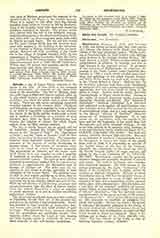

Akhmin, a city of Upper Egypt, situated on the banks of the Nile. Of late years it has attained great importance, on account of the discoveries made in its cemeteries. The hill of Akhmin, some two miles long, is filled with human remains piled up in pits which contain as many as eight or ten small chambers, one above the other, with a dozen coffins in each. There are also caves containing mummies crowded together in the common ditch. Heathens and Christians are heaped together in such a fashion as to make it frequently impossible to say whether the owner of the little articles found near a body was a heathen, a Christian, or a member of some heretical sect, since we know Eutychianism had become the religion of almost the whole Coptic nation, from the fifth century onward.
The city is chiefly famous for its papyri and for its tapestries. Among the former, the fragments known as the “Gospel of Peter”, the “Apocalypse of Peter”, and the “Book of Henoch” hold the first place, but need not be discussed here. The tapestries, however, have furnished material of primary importance to the history of textile handicrafts in ancient times. A few pieces, of uncertain date, were to be found in various European museums. The excavations at Akhmin and the copies made by R. Forrer have now supplied us with a quantity of materials in excellent preservation and of the greatest possible variety. The style of these Akhmin tapestries is sometimes original, but in a great many instances it approximates the decorative type of Roman or Eastern art. The older ones are far superior to the others in design, especially in their treatment of the human figure. The growing want of skill in this regard enables us to trace, step by step, the progress of decadence. These most ancient tapestries are in two colors, yellow and pale brown. With the introduction of polychromy, ornament and animal decoration take the place of human figures. Even this animal decoration is often so angular, so poorly rendered, as to end in outlines resembling geometrical designs.
The discoveries at Akhmin have not been confined to tapestries, though these are of the greatest importance to the history of the industrial arts. Forrer has brought to light ampullae of terra-cotta, clay, and bronze, also jewels and toilet articles of gold or ivory. The discoveries have, however, revealed but few symbolisms not previously known. One tapestry, indeed, shows the Lamb of God, bearing the little banner, which is probably the most ancient example of this still familiar symbolism.
H. LECLERCQ

